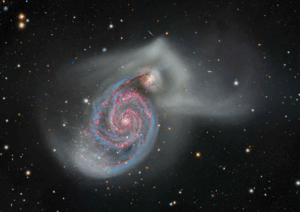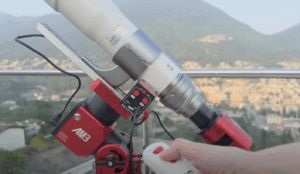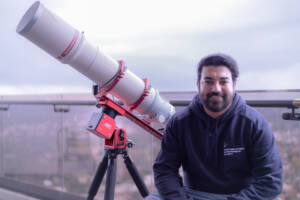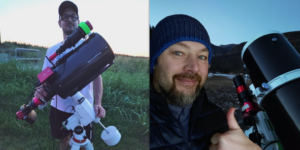
Discovery of the M31 [OIII] emission arc
Recently, a major discovery by an international team of amateur astronomers and scientists has become a huge online hit, and this new discovery is just located in one of the

When it comes to astrophotography, a great influencer on Facebook or YouTube can always teach you a lot at your very beginning stage with his stunning astro images and his experiences in buying and using the dedicated AP equipment. Luca Fornaciari is exactly one of these great influencers. As the Brand Ambassador of ZWO, he has spread and distributed the most trendy ZWO cameras(224, 385, 1600 and above all 294) throughout the Italian market over the past years.
Here we finally got a chance to make an interview with Luca and we’ve like to share it here so that people can know more about this great man and his achievement in astrophotography.
My pleasure. My name is Luca Fornaciari, I live in Italy, I am 36 years old and I deal with photographic and graphic training for work and passion. In the last 9 years I have dedicated myself with great passion to the study of astronomical photography and today I deal with tests for different producers in the world, I organize workshops and courses, dissemination events and activities for children with an astronomical theme.

In 2019 I was awarded in the Italian Parliament for my dissemination activities on astrophotography and I won the first prize in the Abstract category at the Annual Photography Awards.

After the first tests on the tripod and some photographic lenses, I purchased my first reflecting telescope and with a Nikon D7100 I shot for the first time at the Great Orion Nebula.
The experience of the first shot is something unforgettable and his memory will accompany me for the rest of my life. At first you can’t believe that the one on your image is really a nebula hundreds of light years away in the cosmos. You feel that you have really accomplished something great.
By simply starting to publish my photos on Facebook I started receiving messages from many people asking me how to start doing astrophotography. So one day I thought it would be helpful to tell my YouTube experience. I started in 2016 and in a short time a simple idea turned into a bigger project. In Italy there were no YouTube channels dedicated to astronomical photography and the consensus grew very quickly. Today I have the reference channel and some of the largest Facebook and Telegram online communities in Italy, with many people who help me manage and grow a large family of night sky enthusiasts.
organizing astrophotography workshops all over the country, I am often traveling and I happen to photograph under so many different skies. But it is at home that I work and make my main images. Over the years I have built a small private observatory with some automated workstations that allow me to test the equipment, photograph and observe the sky on every clear night. My sky is in a suburban area (SQM 19.60), still accessible to broadband but with a fairly polluted sky.

My observatory is located in Italy, in the province of Modena. It is located in the countryside, under a suburban sky and with an SQM of around 19.60. The work on the structure never ends, every year I try to expand the observatory to be able to always host new workstations and allow me to increase the testing services.
In fact, a few days ago I completed a new box for an automatic and remote telescope.

I regularly change many instruments, but one of my favorites is certainly composed of a Sky-Watcher 200/800 f/4 on AZEQ6-GT and my ASI 294 MC Pro.

I met ZWO in my amateur astronomy association, starting to use an ASI 120 many years ago, but my first cameras that I bought were the ASI 224 and the ASI 294
A matter of habit, probably. Fortunately I’m a person who doesn’t need much sleep: D
Of course, I organize courses, webinars, one-to-one lessons, 48-hour field workshops, photographic exhibitions, dissemination evenings, workshops and readings for children and public observation evenings.
Astrophotography does not only allow you to make images. Access to and understanding of the night sky must broaden our overall vision. Allow us to live a more conscious and better life, towards ourselves and towards others. Astrophotography must be an experience of humility, as taught by Carl Sagan, the person from whom I draw most inspiration and to whom I have dedicated the name of my observatory.
My recommendation is not to get discouraged, not to be frightened by the failures and problems that an astrophotographer often finds himself solving. This is the very essence of astrophotography. The beauty of astrophotography is the path itself, not just the result.
Today, the new CMOS sensors allow many more people to be able to start making astrophotography with more affordable costs. My ASI 294 is a camera that I would not sell for anything in the world, it is an instrument with affordable costs, versatile and exceptional performance.
Of course, until now I have been able to use the cameras for a long time: ASI 120, 120 mini, 1600 M, 183 M, 224, 385, 294 MC Pro, 533, 071, 178 and 2600. I have tried and purchased the EAF focuser and the ADC and I participated in the beta tests of Asi Air and Asi Air Pro.
My favorite cameras are definitely the Asi 294 MC Pro for the color and the 1600 as a monochromatic solution. However, I was very impressed with the performance of the Asi 2600 which could finally replace the 294. I am also very intrigued by the specifications of the 6200 which I hope to try soon. On these rooms I am preparing many accurate tests that I will present in the next few months, but I can already say that the new 2600 has truly superlative properties.

ZWO ASI 2600 MC Pro
(please feel free to tell us the real thoughts in your mind ;D
The ASI 294 is my favorite CMOS color camera. It is the camera that I use more often and with more satisfaction, but the ASI 2600 (which seems to be an enhanced version of the ASI 071) still has a good FWC, but with an extremely larger format and a high QE. It is free of Amp Glow, has little Fixed Pattern Noise and an internal anti-dew resistance. It does not have the same cost as the ASI 294 and this perhaps makes them little comparable. They are two exceptional color cameras and I am convinced that the ASI 2600 will receive as many consents as the ASI 294 has received.
I tried Asi Air in its beta version, and I remember how much work there was still to be done to improve it. ZWO in these years has done an exceptional job to achieve what Asi Air can do today. It is a tool that is worth having because it allows you to simplify the setup in an incredible way, especially if you are traveling.
Asi Air Pro is an evolution of the first model that still adds new functions and compatibility for the new cameras. The thing that convinces me to recommend this tool to everyone is the ability to simply manage the sequence of shots, plate solving, driving, dithering, meridian flip, integrated storage of photographs and the ability to view from your smartphone. the FIT taken, not forgetting the new Live Stack function, exceptional!

ZWO has always managed to create targeted and effective products. The ZWO tools always manage to manage at best the software part, very important, ensuring a wide native compatibility, offering stable drivers and presenting solutions that most of the time do not have many bugs to fix. The thing that convinces me most about ZWO is also in the assistance and commitment that the company puts into optimizing and solving any problem. The great thing about ZWO tools is that during their life they “improve” through continuous updates and corrections.

there is a simple phrase that I think expresses the maximum goal for an astrophotographer: to achieve the highest SNR with point stars.
This already expresses everything you need to do on the field. First of all, have a good equatorial mount and learn to use it correctly. Then choose a telescope suitable not only for photography, but also with the right sampling with respect to the camera. Optimize the autoguide, shutter speed and camera settings (on most deep sky cameras I use zero gain or unity gain).

It is always necessary to remember one fundamental thing: the better the shots acquired, the lower the post-production.
For the development of my images I mainly use PixInsight and Adobe Photoshop, but the important thing to always keep in mind is not to spoil the material and not introduce defects during the post-production process. Small steps, in each step and often compare the result with the starting point.

I am developing a large project to create an online portal that collects events on the Italian territory and web content (courses, lessons, video reviews, articles and publications), where you can involve many good astrophotographers and create a large “web container” where you can have access to any type of information to get closer to amateur astronomy and astronomical photography.
www.lucafornaciarifotografia.com

Recently, a major discovery by an international team of amateur astronomers and scientists has become a huge online hit, and this new discovery is just located in one of the

I was born in Guadalajara, I’m 38 years old, a musician, communications and electronics engineer, and president of the Guadalajara Astronomical Society A.C. since 2020. First Contact with Astronomy Since

This stunning collaborative project comes from astrophotographers Alex Linde and Thomas Hansson, who joined forces across borders to photograph the Whirlpool Galaxy from Sweden, Poland, and Texas, USA. Thomas traveled across


“Two thoughts immediately crossed my mind—the vastness of the cosmos, and that I could also create images like the ones that inspired me.” ” If you spend more time debugging than

Starting the Journey For Giovanni Pasquetto, the passion for the cosmos began in 2007 when he bought his first telescope—a small Newtonian—for his son. That initial curiosity sparked a love